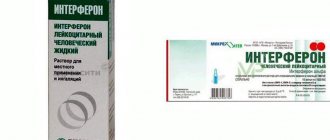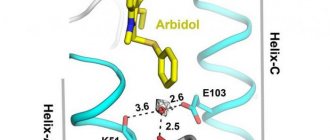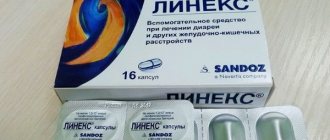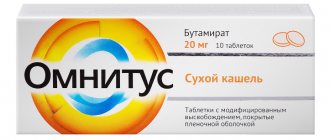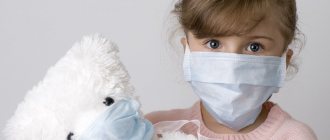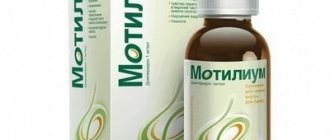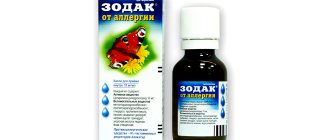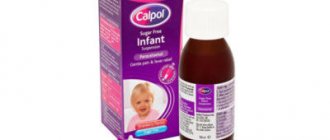Compound
The medicine contains ibuprofen and paracetamol as active ingredients.
In addition to them, Ibuklin contains the following substances as additional components:
- MCC;
- maize starch;
- glycerol;
- E-551;
- E-572;
- E-446.
The tablet shell is formed by the following substances:
- E-553b;
- twin-80;
- E-464;
- E-110;
- titanium white;
- propylene glycol;
- aluminum varnish;
- E-200;
- Dimethicone
Ibuklin Junior tablets contain the following auxiliary components:
- milk sugar;
- maize starch;
- MCC;
- E-124;
- glycerol;
- Aerosil;
- sodium carboxymethyl starch;
- orange and pineapple fragrance;
- peppermint oil;
- E-553b;
- aspartame;
- E-572.
conclusions
Cons of Ibuklin . Like any other medicine, Ibuklin for children has contraindications and limitations. And this list is quite wide. It is also unknown how it affects children with low body weight and children under 3 years of age.
Advantages of Ibuklin for children . The effectiveness of this medicine for fever is undeniable. The minimal presence of additional substances and the only possible composition of active ingredients make it one of the main inhabitants of every mother’s home medicine cabinet.
Expert advice ! Before giving this medicine you should consult your doctor and weigh the pros and cons. If there is any doubt about taking this medicine, replace it with a proven drug!
Share link:
Share link:
- Click to print (Opens in new window)
- Send this to a friend (Opens in new window)
- Click to share on Twitter (Opens in new window)
- Click here to share content on Facebook. (Opens in a new window)
- Click to share on LinkedIn (Opens in new window)
Operating principle
The therapeutic effect of the drug is explained by the following active ingredients:
- Ibuprofen. Belongs to the group of non-steroidal anti-inflammatory drugs. Ibuprofen suppresses COX 1 and 2, these enzymes disrupt the metabolism of arachidonic acid, resulting in a decrease in the formation of prostaglandins, which support the inflammatory process in the body and are responsible for the rise in temperature and the appearance of pain.
- Paracetamol. It non-selectively suppresses COX, lowers high fever, and eliminates pain. But paracetamol has a weak anti-inflammatory effect.
In combination, these substances have a stronger effect than individually.
Ibuprofen and Paracetamol have proven their effectiveness during clinical studies.
Pharmacokinetics
After the active components of the drug enter the digestive tract, they are quite quickly absorbed into the systemic bloodstream. Paracetamol penetrates well through various barriers, but almost does not pass into breast milk. When examining it, no more than 1% of the component was found.
The substance does not accumulate in tissues and internal organs; its maximum concentration in the blood is detected 2 hours after taking a single dosage of the medication. The main amount of paracetamol is processed in the liver, where it breaks down into metabolites. Almost all metabolic products are excreted through the kidneys within 6-8 hours after the last use of the drug.
Ibuprofen is absorbed somewhat better in the gastrointestinal tract and almost completely enters the patient’s blood, providing a therapeutic effect. Its metabolites also do not accumulate in the body, which significantly reduces the risk of overdose, but does not eliminate it. 60 minutes after consuming the tablet, the maximum concentration of the active ingredient in the blood is observed.
The component binds well to plasma proteins, and its bioavailability, unlike paracetamol, reaches 90%. Thanks to this indicator, the effectiveness of the medicine is ensured.
It is worth noting that ibuprofen accumulates in greater quantities in the synovial fluid, in the connective and cartilage tissue of the joints. Its concentration in them is slightly higher than in the blood. The ingredient is processed in the liver.
The period of removal of ibuprofen from the body takes up to 8 hours. In this case, most of the metabolites are evacuated by the kidneys, a small amount is excreted in the bile.
Indications
Ibuklin is prescribed to children to normalize high fever and relieve various pain sensations. It helps with headaches, dental, joint and muscle pain. The drug is recommended for pain caused by bruises, fractures, sprains, dislocations, after surgery and injury. It helps with painful menstruation.
It should be given as an auxiliary medication to relieve pain and lower temperature in case of sinusitis, sore throat, pharyngitis, tracheitis, laryngitis.
When is the remedy prescribed?
Ibuklin Junior is intended for use in children aged 3 to 12 years, for the treatment of the following disorders:
- with increased temperature and feverish state;
- for pain of various origins (dental, muscle, bruises and other injuries);
- in complex therapy of infectious and inflammatory processes localized in the upper parts of the respiratory system.
Taking Ibuklin Junior in children to relieve fever should be carried out under the strict supervision of adults and in accordance with the regimen prescribed by the pediatrician. If hyperthermia lasts more than three days, use of the drug should be discontinued.
Instructions for use
Before or after meals?
You need to take the antipyretic drug 2 or 3 hours before and after meals.
Ibuklin (regular)
The tablets should be swallowed whole with water. The medication should be taken 1 tablet. twice or thrice a day. You should take the next dose no earlier than after 4 hours. If the child has problems with the kidneys and liver, then the time interval should be increased to 8 hours.
Ibuklin Junior (children)
Before taking the Ibuklin Junior tablet, it must be dissolved in 5 ml of water. The daily dose should be divided into 2-3 doses. The minimum time interval should be 4 hours, and in case of liver or kidney pathologies it should be increased to 8 hours.
The medicine should be given to children in the following dosages:
| Number of completed years and weight | Daily dosage |
| Age from 3 to 6 years and body weight from 13 to 20 kg | You need to take the medicine 1 tablet three times a day. |
| Age from 6 to 12 years and weight from 20 to 40 kg | The daily dosage is 6 tablets. |
In what form is it produced?
The pharmacological agent can be found on pharmacy shelves in the form of small, pink, round, dispersible tablets. The tablets are round, have a stripe on one side, packaged in blisters of 10 pieces. The cardboard box contains not only plates with tablets, but also instructions for their correct use.
Individual packaging may contain 1 or 2 blisters. When the tablet dissolves, a mint aroma is clearly felt, and when consumed, the patient can feel its taste, as well as the smell of strawberries. The product does not have a bitter aftertaste, which also makes it easier to take. In addition, it dissolves very quickly, which is an advantage over conventional tablets.
The cost of the medicine depends on the region of its distribution, as well as the number of tablets in the package. The average price for 20 tablets is 120-130 rubles.
Contraindications
Ibuklin is contraindicated for children with the following health problems:
- intolerance to the composition of the medication;
- exacerbation of peptic ulcer;
- bleeding from the digestive tract;
- renal dysfunction when the renal blood flow rate is less than 30 ml per minute;
- intolerance to acetylsalicylic acid and other NSAIDs, which is accompanied by bronchial asthma and hay fever;
- damage to the optic nerve;
- G-6-FDG deficiency;
- blood pathologies;
- severe liver dysfunction;
- intestinal inflammation;
- elevated blood potassium level, which is confirmed;
- progressive kidney pathology.
The medication should not be given to children who have undergone coronary artery bypass surgery.
Drug interactions
Ibuklin Junior for children with fever (reviews should be studied before taking the tablets) is not prescribed simultaneously with medications containing the same active ingredients. Do not use the medicine in combination with indirect anticoagulants, as well as glucocorticosteroids, which increase the risk of exacerbation of ulcerative lesions of the digestive tract.
The use of Ibuklin with diuretics, antacids and antibiotics from the cephalosporin group is contraindicated. It is allowed to combine the drug with vascular, antihypertensive, and mucolytic drugs. There are no negative reactions when combined with hepatoprotectors, nootropics and sedative medications.
You should not take the medicine simultaneously with cardiac glycosides or hypoglycemic agents, as their effect is enhanced. In each case, the decision on the combination of one or another medication is made by the doctor.
Side effects
Ibuklin in children can cause the following undesirable reactions:
- dyspeptic symptoms;
- liver damage;
- decrease in the number of platelets and leukocytes;
- allergies, which are manifested by itching, nettle fever, and rash.
If the recommended dosage is exceeded, the medication can cause an overdose, which is manifested by symptoms such as:
- loose stools, nausea, vomiting, refusal to eat, stomach pain;
- tinnitus;
- headache;
- arrhythmia;
- lethargy;
- hypotension;
- disorder of consciousness;
- depression;
- drowsiness;
- liver and kidney damage;
- depression;
- convulsions;
- prolongation of bleeding time.
If symptoms of overdose appear, if no more than 4 hours have passed after taking the medicine orally, you need to rinse the stomach and give the child activated charcoal. It is also recommended to administer methionine and N-acetylcysteine, take antacids, and symptomatic therapy. In case of overdose, hemodialysis is effective.
What does it help with?
Ibuklin for children has the ability to relieve symptoms that accompany colds and viral diseases: fever, fever, inflammation. The use of the drug helps to improve the patient’s condition with inflammatory diseases of the joints - it reduces swelling of the periarticular tissues, increases freedom of movement, and relieves stiffness in the morning. To relieve pain of moderate intensity, the drug is taken when:
- inflammatory or degenerative diseases of the musculoskeletal system (arthritis, osteoarthrosis, osteochondrosis);
- inflammation of periarticular tissues (tenosynovitis, bursitis);
- neuralgia;
- myalgia;
- pain arising after injuries (bruises, sprains, dislocations, fractures, tissue damage);
- toothache or headache (migraine).
Ibuklin or Nurofen?
The therapeutic effect of Nurofen is explained by ibuprofen. It is produced in suspension, suppositories, tablets, capsules, gel. In a suitable release form, it is available to patients older than 3 months. Nurofen suppositories are convenient if the child is vomiting.
The medications have similar indications, but the doctor must decide which one is better, since contraindications and tolerability of therapy must be taken into account.
Analogs
If there are contraindications to the components of Ibuklin, the doctor prescribes other medications. You can order in a pharmacy chain or buy analogues of the drug in an online store from a catalog. To relieve fever, lower body temperature, and eliminate pain, the following drugs are used:
- Ibuprofen Junior (Ibuprofen Junior);
- Brustan;
- Nurofen;
- Next;
- Khairumat;
- Ibuza;
- Spondifen.
Nimulid or Ibuklin?
The therapeutic effect of Nimulid is explained by nimesulide. It is available in suspension, gel, tablets. Nimulid in liquid form can be taken by children over 3 years of age.
The medication is recommended not only for lowering temperature and relieving pain, but also for suppressing inflammation in osteoarthritis, bursitis, tendinitis and arthritis of various origins.
The doctor must decide which drug is better, Ibuklin or Nimulid, since they are not interchangeable and it is incorrect to compare them.
Medicine for children
Ibuklin Junior is available in the form of soluble tablets for the preparation of a suspension with a fruit and mint aroma especially for children. The concentration of active components in this dosage form is significantly lower than in the adult product.
According to numerous reviews from doctors and patients, Ibuklin Junior is effective in relieving fever in children, and thanks to its pleasant taste, it is not difficult for parents to give the drug to their child. The medicine begins to act quite quickly, within half an hour the temperature drops and the general condition of the little patient improves.
The drug begins to act 30 minutes after administration.
Taking Ibuklin Junior to bring down the baby’s temperature can only be done after consultation with the attending physician, who will make a diagnosis, make sure there are no contraindications and prescribe appropriate therapy.
Reviews
Parents' opinion
Parents like the following about Ibuklin and Ibuklin Junior:
- the drug helps quickly;
- dispersible tablets dissolve well and are easy to drink;
- The medicine lowers the temperature for a long time.
Negative reviews from moms and dads indicate that the antipyretic may cause allergies.
Doctor Komarovsky's opinion
The famous pediatrician considers paracetamol and ibuprofen the safest drugs for children. He recommends lowering the temperature when the child feels unwell, rather than waiting until it rises to 38 degrees.
The antipyretic drug is available by prescription; only a specialist should decide how to give Ibuklin to a child.
By
Special conditions
When prescribing Ibuklin for children Junior, it is necessary to monitor the child’s blood condition, because the drug can reduce the number of platelets and blood sugar levels. Do not use the medicine for insect and animal bites. Important things to consider:
- Ibuklin is used with other drugs only for the symptomatic treatment of the disease; the medicine does not eliminate the causes of the disease.
- The use of the drug can change the clinical picture of the disease, so the prescription should be made by a doctor after examining the patient.
